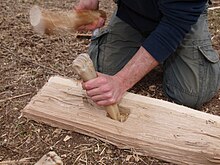Bone tool
Bone tools ( synonymously also bone tools ) belong to the stone tools of the oldest proven utensils and tools of mankind.
Paleolithic in Africa
A bone tip from the Early Stone Age from Swartkrans ( South Africa ), which has not been proven beyond doubt, is associated with Paranthropus robustus . The rejection of the osteodontokeratic culture claimed by Raymond Dart led to a critical view of the early bone devices. In particular, the accumulations of such objects found in caves and under the abyss could be traced back to hyenas who collect bones from large mammals and systematically bite them. The similarity of carnivores- bitten bones makes an objective assessment of such objects with regard to their artificial character more difficult , since bite marks can create similar fracture patterns as a human treatment using the cutting technique .
Old and Middle Paleolithic in Europe
In Europe, too, bone tools are already known from the early Paleolithic . Modifications to animal bones are described for European Homo erectus sites, such as Boxgrove , the Arago Cave near Tautavel , Isernia la Pineta , Atapuerca, and Vértesszőlős . Retouched bone tools from the Bilzingsleben site are still controversial today. Relatively convincing double- sided bones made from compact fragments of Palaeoloxodon antiquus from the Middle Pleistocene have been found in the vicinity of Rome, in Fontana Ranuccio, Castel di Guido and La Polledrara. In Rhede ( Borken district , North Rhine-Westphalia ) a hand ax was found that was made from the thigh of a mammoth and is assigned to the Moustérien . It dates back to the early to middle Vistula Ice Age , around 100,000 to 40,000 years ago .
Bone tools of the Neanderthals were usually from long bone chips manufactured by large mammals. According to a revision of the bone material from the La Quina site in southern France, published in 2010 , the fragment of a Neanderthal skullcap would have served as a retoucher for working flint tools, which, according to the authors, would have been suggested by corresponding impact marks (impact marks) on the bone surface. Alternatively, this object could also be a skull fragment with a carnivore bite , which can be checked by diagnosing the superficial scratches. Bones in paleolithic hunting camps often remained in large numbers after the group of people moved on and were then bitten by carnivores. In addition to traces of decomposition by humans, they therefore often also have tooth scratches from subsequent use by carnivores, which can be confused with human cutting traces .
The first bone peaks can be found in the time horizon of the Neanderthals, for example from the Salzgitter-Lebenstedt sites (the Micoquien site , around 55,000 years old) and from approximately the same old layers of the Great Grotto near Blaubeuren .
Upper Paleolithic
With the aurignacia , bone spikes occur en masse. Some 35,000 to 40,000 year old bone tips with a split base are available, for example, from the Vogelherd Cave and the Geißenklösterle near Blaubeuren . From this time on there were also art objects and jewelry made of bones ( cf. Upper Palaeolithic small art ).
Most of the bone artifacts have come down to us from Magdalenian (around 18-12,000 BC). Parts of hunting and fishing equipment , everyday hand tools and musical instruments ( flutes , buzzers ) are made from bones. The increasing use of bones may be due to the lack of suitable wood during the Ice Age . For example, the following items were made from bones: awls , fishhooks , gouges , drills, ax and adze blades , daggers , pressure rods, projectile points, smoothers , hoes , harpoons , hollow drills, hollow chisels , clubs , sewing needles , needle boxes, chisels and cross rods (special form of Fishing hook). The oldest polished bone chisel comes from Přezletice in the Czech Republic and is around 700,000 years old.
The use of bones as tools or implements (needle, comb) continued into the Middle Ages.
See also
literature
- Emil Hoffmann: Lexicon of the Stone Age (Munich 1999) p. 210 ISBN 3-406-42125-3 .
- H. Reich: Neolithic bone tools from Lohberg near Gräfentonna (Ldkr.Gotha) 1934
Web links
Individual evidence
- ^ Raymond Dart: The Osteodontoceratic culture of Australopithecus prometheus . Transvaal Museum Pretoria, 1957
- ↑ Leif Steguweit: Traces of use on artifacts from the hominid discovery site in Bilzingsleben (Thuringia) . Tübingen works on prehistory, Volume 2, VML Verlag, Rahden / Westf. 2003, ISBN 3-89646-852-9 ( PDF download )
- ^ Segre, A. & A. Ascenzi (1984): Fontana Ranuccio: Italy's Earliest Middle Pleistocene Hominid Site. - Current Anthropology 25, 230-233.
- ↑ Pitti, C. & AM Radmilli (1984): La stazione del Paleolitico inferiore s Castel di Guido presso Roma, Atti XXIV. - Riunione Scient.Ist.Ital.Preist.Protoist., Pp. 73-87
- ↑ Anzidei, AP, F. & L. Angelelli Caloi (1989): Le gisement Pleistocene de la Polledrara di Cecanibbio (Rome, Italy). - L'Anthropologie 93, pp. 749–781
- ↑ C. Verna, F. d'Errico: The earliest evidence for the use of human bone as a tool. Journal of Human Evolution (online 4 December 2010) doi : 10.1016 / j.jhevol.2010.07.027
- ↑ Timothy Champion, Clive Gamble, Stephen Shennan , Alisdair Whittle: Prehistoric Europe , edited by: Left Coast Press , 2009


